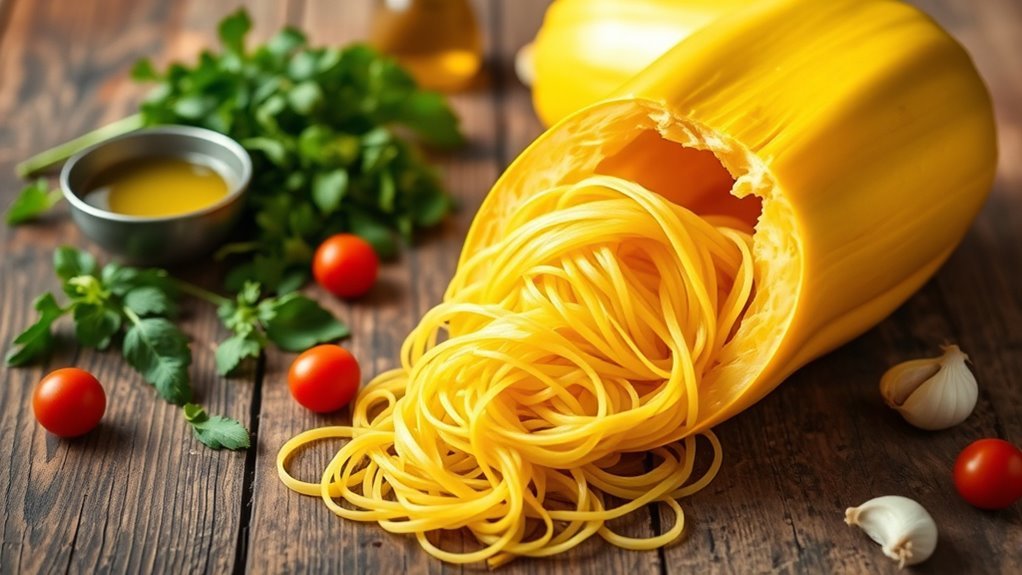Yes, spaghetti squash is keto-friendly! It offers a low-carb alternative to traditional pasta with only about 5 grams of net carbs per cup, making it great for a ketogenic diet. This unique vegetable is not only low in calories but also rich in vitamins A and C, contributing to your overall health. You can effectively pair it with healthy fats and proteins for satisfying meals. Stick around to explore tasty recipes and serving ideas that fit perfectly within your keto lifestyle.
What Is Spaghetti Squash?

Spaghetti squash is a unique winter vegetable that offers a low-carb alternative to traditional pasta. Its origins trace back to Central America, where it was cultivated for centuries, and today, you can find various spaghetti squash varieties, including the popular yellow and the lesser-known orange types. These vegetables are known for their oblong shape and pale yellow skin, making them an attractive addition to your meals. When cooked, the flesh separates into strands resembling spaghetti, hence the name. You can prepare it in multiple ways, from roasting to steaming, allowing you to enjoy its versatility. Whether you’re looking to reduce carbs or simply explore new flavors, spaghetti squash can be a delightful choice in your culinary adventures.
Nutritional Profile of Spaghetti Squash

While many people seek low-carb options for their meals, the nutritional profile of spaghetti squash makes it an appealing choice. This versatile vegetable comes in various spaghetti squash varieties, each with unique flavors and textures. You can prepare it using different cooking methods, like roasting, steaming, or microwaving, to suit your taste.
Here’s a quick nutritional overview:
| Nutrient | Per 1 cup (cooked) | % Daily Value |
|---|---|---|
| Calories | 42 | 2% |
| Carbohydrates | 10g | 3% |
| Fiber | 2g | 8% |
| Protein | 1g | 2% |
| Fat | 0.5g | 1% |
With its low calorie and carb content, spaghetti squash supports a balanced diet.
Carbohydrate Content Breakdown

When considering spaghetti squash for a keto diet, it’s crucial to understand its carbohydrate content. You’ll want to look at the nutritional profile, particularly the net carbs, which can help you make informed choices. Comparing it to other vegetables can also provide clarity on where it stands in your meal planning.
Nutritional Profile Overview
The nutritional profile of spaghetti squash makes it an intriguing option for those following a keto diet. This vegetable offers several spaghetti squash benefits that can align with your dietary needs. Here’s a quick breakdown of its carbohydrate content:
- Low in Calories: Approximately 42 calories per cup.
- Net Carbs: Contains about 7 grams of total carbs, appealing for keto diet compatibility.
- Fiber: Provides around 2 grams of fiber, which can support digestive health.
- Vitamins: Rich in vitamins A and C, contributing to overall wellness.
Net Carbs Calculation
Understanding net carbs is essential for anyone on a keto diet, especially when considering foods like spaghetti squash. This unique vegetable contains about 7 grams of total carbohydrates per cup, but it also has approximately 2 grams of fiber. Since fiber isn’t digested, you can subtract it from the total carbs, resulting in around 5 grams of net carbs per serving. This low net carb count makes spaghetti squash a great option for those looking to maintain ketosis. Additionally, spaghetti squash offers numerous health benefits, including vitamins A and C, which can support overall wellbeing. By incorporating this versatile veggie into your meals, you can enjoy delicious dishes without compromising your keto goals.
Comparison With Other Vegetables
While many vegetables can fit into a keto diet, their carbohydrate content varies considerably, making it essential to compare them to options like spaghetti squash. This unique vegetable offers several benefits while keeping carbs low. Here’s how it stacks up against some popular vegetable alternatives:
- Zucchini: 3 grams net carbs per cup.
- Cauliflower: 2 grams net carbs per cup.
- Broccoli: 4 grams net carbs per cup.
- Bell Peppers: 6 grams net carbs per cup.
Spaghetti squash, with roughly 5 grams net carbs per cup, provides a versatile, satisfying option. By understanding these comparisons, you can make informed choices about which vegetables will best support your keto journey while enjoying the delicious spaghetti squash benefits.
Comparing Spaghetti Squash to Traditional Pasta
When you compare spaghetti squash to traditional pasta, it’s clear that they offer distinct nutritional profiles and culinary experiences. Spaghetti squash is a fantastic low-carb alternative, providing a unique spaghetti texture that many find satisfying. It contains fewer calories and carbs than traditional pasta, making it a popular choice among those following keto or low-carb diets. On the other hand, traditional pasta offers a more familiar taste and texture, often favored in classic dishes. While pasta has more protein and fiber, spaghetti squash shines as a nutritious, gluten-free option. If you’re exploring pasta alternatives, consider how these two options can fit into your meals, balancing your dietary needs with your culinary desires.
Health Benefits of Spaghetti Squash
Spaghetti squash is a fantastic option if you’re looking to cut down on carbohydrates while still enjoying a satisfying meal. Not only is it low in carbs, but it’s also packed with essential nutrients like vitamins A and C, potassium, and antioxidants. Incorporating spaghetti squash into your diet can support overall health while aligning with your keto-friendly lifestyle.
Low in Carbohydrates
A nutritious choice for those on a keto diet, spaghetti squash is remarkably low in carbohydrates compared to traditional pasta options. This makes it an excellent alternative for anyone looking to maintain a low carb diet. Here are some spaghetti squash benefits that might interest you:
- Low Calorie: It’s a filling food without the calorie overload.
- Blood Sugar Friendly: Keeps your blood sugar levels stable, thanks to its low glycemic index.
- Versatile: You can use it in various recipes, from casseroles to salads.
- Satisfying Texture: Its noodle-like strands mimic pasta, making it a delightful swap.
Enjoy the freedom to indulge in delicious meals while sticking to your health goals with this fantastic veggie!
Rich in Nutrients
With just one cup of cooked spaghetti squash containing around 42 calories and a wealth of vitamins and minerals, it’s no wonder this vegetable is celebrated for its nutritional profile. Its nutrient density is impressive, providing essential vitamins like A, C, and several B vitamins. These nutrients support immune function, skin health, and energy metabolism. Spaghetti squash also offers a good amount of fiber, promoting digestive health and aiding in satiety. Plus, its low-calorie count means you can enjoy it freely while sticking to your health goals. By incorporating spaghetti squash into your meals, you’re not just adding a versatile ingredient; you’re enhancing your diet’s vitamin content and overall wellness. So go ahead, relish the benefits of this nutritious squash!
How to Prepare Spaghetti Squash
Preparing spaghetti squash is a straightforward process that can yield delicious, low-carb noodles. You’ll love how easy it is to incorporate this veggie into your meals! Here are some effective cooking techniques:
Spaghetti squash is a simple, tasty way to enjoy low-carb noodles in your meals!
- Roasting: Cut the squash in half, scoop out the seeds, and bake at 400°F for about 40 minutes.
- Microwaving: Prick the squash with a fork, microwave for 10-12 minutes, flipping halfway through.
- Boiling: Cut the squash into quarters and boil for about 20-25 minutes until tender.
- Instant Pot: Place the whole squash on a trivet with a cup of water, cook on high pressure for 10 minutes.
Once cooked, try various seasoning options like garlic, olive oil, or Parmesan to enhance the flavor!
Keto-Friendly Recipes Using Spaghetti Squash
If you’re looking to add variety to your keto meal plan, spaghetti squash offers a versatile base for many delicious recipes. One tasty option is a spaghetti squash stir fry, where you can sauté your favorite low-carb vegetables and proteins, creating a satisfying dish that satisfies cravings without breaking your carb count. Another delicious choice is a creamy spaghetti casserole, combining cooked spaghetti squash with melted cheese, cream, and herbs for a comforting meal. You can even include cooked chicken or ground beef for added protein. Both recipes are not only keto-friendly but also allow you to enjoy the flavors you love while maintaining your dietary goals. Embrace these creative dishes, and you’ll never feel deprived on your keto journey!
Portion Control and Serving Suggestions
When it comes to enjoying spaghetti squash on a keto diet, portion control is key to managing your carbohydrate intake. A recommended serving size is typically around one cup, which pairs well with proteins like chicken or shrimp for a balanced meal. You can also enhance flavors with low-carb sauces, keeping your dish both satisfying and keto-friendly.
Recommended Serving Size
Understanding the recommended serving size of spaghetti squash is essential for maintaining a keto-friendly diet. Proper portion control can help you enjoy this versatile vegetable without overdoing your carb intake. Here’s a quick guideline for serving size:
- One cup of cooked spaghetti squash contains about 10 grams of carbs.
- Two cups is a generous serving, but be mindful of your overall carb count.
- Pair it with healthy fats to enhance flavor and satisfaction.
- Monitor your intake if you’re sensitive to carbs or tracking macros closely.
Pairing With Proteins
Pairing spaghetti squash with protein sources can elevate your meals while keeping them keto-friendly. Consider combining it with grilled chicken, shrimp, or sautéed tofu for satisfying protein pairings. These meal combinations not only enhance flavor but also provide essential nutrients that support your low-carb lifestyle.
When serving, aim for a balanced plate; about one cup of cooked spaghetti squash paired with four to six ounces of your chosen protein is a great guideline. This portion control helps maintain your keto goals without sacrificing enjoyment. Feel free to experiment with different proteins, like beef or turkey, to keep your meals exciting while ensuring you stay within your carbohydrate limits. Embrace the freedom of creating delicious, nutritious dishes that align with your dietary choices!
Low-Carb Sauces Options
To enhance the flavor of spaghetti squash while keeping your meal low in carbs, consider incorporating a variety of low-carb sauces. Here are some delicious options you can try:
- Low Carb Marinara – Opt for brands that use no added sugars, or make your own with crushed tomatoes, garlic, and herbs.
- Creamy Alfredo – A rich sauce made with heavy cream, butter, and parmesan cheese can elevate your dish without the carbs.
- Pesto – Blend fresh basil, garlic, nuts, and olive oil for a vibrant sauce that’s both flavorful and low in carbs.
- Garlic Butter – Melted butter with minced garlic adds a savory touch that complements the natural sweetness of spaghetti squash.
Experiment with portion control, and feel free to mix and match these sauces for a satisfying meal!
Other Low-Carb Alternatives to Consider
While spaghetti squash is a popular choice for those following a low-carb diet, there are several other alternatives that can also fit seamlessly into your meal plan. Zucchini noodles, or “zoodles,” are a versatile option that can easily replace traditional pasta. They’re low in carbs and provide a satisfying texture, making them perfect for your favorite sauces. Another great alternative is cauliflower rice, which can serve as a fantastic base for stir-fries or grain bowls. It’s low in calories and carbs, and it absorbs flavors well. Incorporating these options into your meals can enhance variety while keeping your carb count in check, granting you the freedom to enjoy delicious, satisfying dishes without compromising your dietary goals.
Final Thoughts on Spaghetti Squash in a Keto Diet
As you evaluate incorporating spaghetti squash into your keto diet, it’s important to weigh its nutritional benefits against your specific carbohydrate goals. While spaghetti squash can fit into a low-carb lifestyle, it’s essential to approach it mindfully. Here are some points to examine:
- Carbohydrate Content: One cup has about 7 grams of carbs, which can add up quickly.
- Fiber Benefits: It provides fiber, aiding digestion and promoting fullness.
- Versatility: Use it in various dishes as a pasta substitute or in casseroles.
- Nutrient-Rich: It’s packed with vitamins A and C, supporting overall health.
Ultimately, if it fits your macros, spaghetti squash can be a delicious and nutritious addition to your keto diet.
Frequently Asked Questions
Can Spaghetti Squash Be Eaten Raw?
You can eat raw spaghetti squash, but it’s not very common. While raw spaghetti has some nutritional benefits, like fiber and vitamins, the texture can be tough and less palatable than when cooked. If you decide to try it raw, consider grating or spiralizing it for a salad or slaw. Just remember, cooking often enhances the flavor and makes the nutrients more accessible, so weigh your options before diving in!
How Does Spaghetti Squash Affect Blood Sugar Levels?
Spaghetti squash has a low carb content, which means it typically won’t spike your blood sugar levels as dramatically as higher-carb options. With about 7 grams of carbs per cup, it’s a great choice if you’re monitoring your blood sugar. Its fiber content also helps slow digestion, further stabilizing your levels. You’ll likely find it a satisfying alternative in meals without the worry of significant blood sugar fluctuations.
Is Spaghetti Squash Suitable for Paleo Diets?
Yes, spaghetti squash is suitable for paleo diets. It offers several paleo benefits, including being low in carbs and high in fiber, which can help maintain stable blood sugar levels. This squash is also packed with vitamins and minerals, making it a nutritious alternative to traditional pasta. You can enjoy it roasted or steamed, allowing you the freedom to explore various recipes while staying aligned with your paleo lifestyle.
Can I Freeze Cooked Spaghetti Squash?
Yes, you can freeze cooked spaghetti squash! To do it right, use proper freezing techniques. First, let the squash cool completely, then scoop out the strands and pack them in airtight containers or freezer bags. Make sure to remove as much air as possible to prevent freezer burn. For storage tips, label the bags with the date, and use them within three months for the best flavor and texture. Enjoy your meal prep freedom!
What Are the Best Seasonings for Spaghetti Squash?
When it comes to enhancing spaghetti squash, you’ll find that the best flavor combinations often include garlic, olive oil, and parmesan, while popular seasoning blends like Italian herbs or smoked paprika add depth. You can balance zest and warmth by pairing lemon zest with chili flakes, creating a dish that’s both bright and comforting. Experimenting with these seasonings lets you embrace creativity while enjoying a nutritious meal that satisfies your taste buds.


